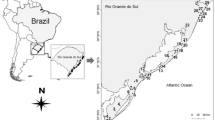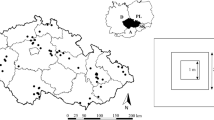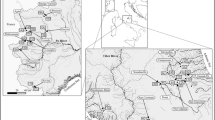Abstract
Data on seasonal variability in emergent macrophyte communities in regard to the composition of statistically significant indicator species remain incomplete. It was recognized by the authors as a potentially significant scientific issue and was defined as the main objective of this study. Information on the floristic composition of the communities included in this paper were collected in the Central Balkan Peninsula. Using a combination of cluster analysis and indicator species analysis, 11 emergent macrophyte communities were established. The seasonal dynamic of these communities did not include statistically significant modification of either the floristic composition or the species abundances according to the results of permutational multivariate analysis of variance (PERMANOVA). Nevertheless, seasonal variability in three communities - the Sparganium erectum community, Scirpus lacustris community and Typha angustifolia community - was registered in regard to the composition of their statistically significant indicator species. Disturbances primarily related to water level fluctuation in their habitats initiated a significant increase or decrease in the abundances of particular species. These slight structural changes were sufficient to induce a changeability in these communities in terms of the composition of their statistically significant indicator species over the growing season without a significant impact on the PERMANOVA results. This relatively “concealed” changeability of plant communities could have serious consequences on the processes of both defining and describing vegetation units because the indicator species are often used as “diagnostic species”. Consequently, future ecological studies should be more focused on investigating seasonal variability in diverse vegetation types in order extend our knowledge in this area.
Similar content being viewed by others
References
Anderson M.J., Gorley R.N. & Clarke K.R. 2007. Permanova+ for Primer: Guide to Software and Statistical Methods. PRIMER-E, Plymouth, United Kingdom, 21. pp.
Anonymous 1992. Council Directive 92/43/EEC of 2. May 199. on the conservation of natural habitats and of wild fauna and flora. The Council of the European Communities.
Babić N. 1971. Močvarna i livadska vegetacija Koviljskog rita. Zbornik Matice srpske, Ser. prirodnih nauka, Novi Sad 41: 19–87.
Braun-Blanquet J. 1951. Pflanzensoziologie. Springer, Wien.
Campbell C.J., Johns C.V. & Nielsen D.L. 2014. The value of plant functional groups in demonstrating and communicating vegetation responses to environmental flows. Freshwater Biol. 59: 858–869.
Casanova M.T. & Brock M.A. 2000. How do depth, duration and frequency of flooding influence the establishment of wetland plant communities? Plant Ecol. 147: 237–250.
Chytrý M., Tichý L., Holt J. & Botta-Dukát Z. 2002. Determination of diagnostic species with statistical fidelity measures. J. Veg. Sci. 13: 79–90.
Davies C.E., Moss D. & Hill M.O. 2004. EUNIS habitat classification revised 2004. Report to European Environment Agency-European Topic Centre on Nature Protection and Biodiversity, pp. 127–143.
Dufręne M. & Legendre P. 1997. Species assemblages and indicator species: the need for a flexible asymmetrical approach. Ecol. Monogr. 67: 345–366.
Gradstein S.R. & Smittenberg J.H. 1977. The hydrophilous vegetation of western Crete. Vegetatio 34: 65–86.
Greet J.O.E., Webb J.A. & Downes B.J. 2011. Flow variability maintains the structure and composition of in-channel riparian vegetation. Freshwater Biol. 56: 2514–2528.
Hejný S., Segal S. & Raspopov I.M. 1998. General ecology of wetlands, pp. 1–77. In: Westlake D.F., Kvĕt J. & Szczepański L.A. (eds), The Production Ecology of Wetlands: the IBP synthesis, Cambridge University Press, United Kingdom.
Hrivnák R. 2004. The plant communities of Phragmitetalia in the catchment area of the Ipeĺ river (Slovakia and Hungary) 1. Reed wetlands (Phragmition communis). Biologia 59: 75–99.
Hrivnák R. 2005. Effect of ecological factors on the zonation of wetland vegetation. Acta Soc. Bot. Pol. 74: 7–81.
Hrivnák R., Oťaheľová H. & Gömöry D. 2009. Seasonal dynamics of macrophyte abundance in two regulated streams. Cent. Eur. J. Biol. 4: 241–249.
Hroudová Z., Zákravský P., Ducháček M. & Marhold K. 2007. Taxonomy, distribution and ecology of Bolboschoenus in Europe. Ann. Bot. Fenn. 44: 81–102.
Janković M. 1953. Vegetacija velikog blata. Glas. prirod. Muz. srp. Zem., ser. B, 5-6: 59–111.
Jasprica N., Carić M. & Batistic M. 2003. The Marshland Vegetation (Phragmito-Magnocaricetea, Isoëto-Nanojuncetea) and Hydrology in the Hutovo Blato Natural Park (Neretva River Delta, Bosnia and Herzegovina). Phyton, Horn, Austria 43: 281–294.
Jenačković D., Dimitrijević D. & Ranđelović V. 2010. Macrophytic flora and vegetation of the rivers Svrljiški and Beli Timok (Eastern Serbia). Biologica Nyssana 1: 2–26.
Johnson R.K. 2001. Indicator metrics and detection of impact, pp. 41–44. In: Karttunen K. (ed.), Monitoring and Assessment of Ecological Status of Aquatic Environments, Nordic Council of Ministers.
Jovanović R. 1958. Tipovi močvarne vegetacije u Jasenici. Zbornik Biol. Inst. NR Srbije 2: 1–36.
Kamberović J., Barudanović S., Maši E. & Dedić A. 2014. Marshland vegetation of the order Phragmitetalia on shores of mine pit lakes in north-eastern Bosnia and Herzegovina. Biologica Nyssana 5: 1–10.
Karadžić B. 2013. FLORA: a Software Package for Statistical Analysis of Ecological Data. Water Res. Managem. 3: 45–54.
Keddy P.A. & Reznicek A.A. 1986. Great Lakes vegetation dynamics: the role of fluctuating water levels and buried seeds. J. Great Lakes Res. 12: 25–36.
Kochev H. & Jordanov D. 1981. Vegetation of water basins in Bulgaria. Ecology, protection and economic importance, Publishing House of the Bulgarian Academy of Science, Sofia.
Lakušić R. & Pavlović D. 1976. Vegetacija Skadarskog jezera. Glas. Republ. zavoda za zaštitu prirode i prirodnjačkog muzeja Titograd 9: 45–50.
Lakušić R., Pavlović D., Abadžić S. & Grgić P. 1977. Prodromus biljnih zajednica Bosne i Hercegovine. God. biol. Inst. Univ. Sarajevo 30: 1–87.
Landucci F., Gigante D., Venanzoni R. & Chytrý M. 2013. Wetland vegetation of the class Phragmito-Magno-Caricetea in central Italy. Phytocoenologia 43: 67–102.
Lapointe L. 2001. How phenology influences physiology in deciduous forest spring ephemerals. Physiol. Plantarum 113: 151–157.
Lepš J. & Šmilauer P. 2003. Multivariate analysis of ecological data using CANOCO. Cambridge University Press, United Kingdom, Cambridge.
Mackey R.L. & Currie D.J. 2001. The diversity-disturbance relationship: is it generally strong and peaked? Ecology 82: 3479–3492.
McCune B. & Mefford M.J. 2011. PC-ORD. Multivariate Analysis of Ecological Data. Version 6. MjM Software, Gleneden Beach, Oregon, United States of America.
Micevski K. 1963. Tipološki istražuvanja na blatnata vegetacija vo Makedonija, God. zbor. PMF-biologija, Skopje, 14: 79–130.
Molina J.A. & Moreno P.S. 2003. Diversity of the helophytic vegetation in Spain. Acta Bot. Gallica 150: 167–193.
Mucina L. 1997. Conspectus of classes of European vegetation. Folia Geobot. 32: 117–172.
Mueller-Dombois D. & Ellenberg H. 1974. Aims and methods of vegetation ecology. John Wiley & Sons, New York, 54. pp.
Nowak A., Nowak S. & Nobis M. 2014. Diversity and distribution of rush communities from the Phragmito-Magno-Caricetea class in Pamir Alai mountains (Middle Asia: Tajikistan). Pakistan J. Bot. 46: 27–64.
Nygaard B. & Ejrnès R. 2009. The impact of hydrology and nutrients on species composition and richness: evidence from a microcosm experiment. Wetlands 29: 187–195.
O’Donnell J., Fryirs K. & Leishman M. 2014. Digging deep for diversity: riparian seed bank abundance and species richness in relation to burial depth. Freshwater Biol. 59: 100–113.
Ostendorp W., Jöhnk K.D. & Schmieder K. 2004. Assessment of human pressures and their hydromorphological impacts on lakeshores in Europe. Int. J. Ecohydrol. Hydrobiol. 4: 379–395.
Pelechaty M. 2006. Spatial heterogeneity of physical-chemical properties of substratum and sediment of a shallow lake (Lake Jaroslawieckie, Wielkopolski National Park). Limnol. Rev. 6: 247–254.
Ranđelović V, Matejić J. & Zlatković B. 2007a. Flora and vegetation of Batušinačke swamps near Niš. Proceeding of the 9th Symposium on Flora of Southeastern Serbia and Neighbouring Regions, Niš (Serbia), pp. 19–40.
Ranđelović V., Zlatković B. & Matejić J. 2007b. Swamp vegetation of order Phragmitetalia in southeastern Serbia. Proceeding of the 9th Symposium on Flora of Southeastern Serbia and Neighbouring Regions, Niš (Serbia), pp. 9–18.
Ranđelović V & Zlatković B. 2010. Flora i vegetacija Vlasinske visoravni. Faculty of Sciences and Mathematics, University of Niš, 44. pp.
Riis T. & Biggs B.J.F. 2001. Distribution of macrophytes in New Zealand streams and lakes in relation to disturbance frequency and resource supply-a synthesis and conceptual model. New Zeal. J. Mar. Fresh. 35: 255–267.
Rivas-Martínez S. 2004. Global bioclimatics (version 22-04-04). Phytosociological Research Center. http://www.globalbioclimatics.org/form/maps.htm
Santo D.E. & Arsénio P. 2005. Influence of land use on the composition of plant communities from seasonal pond ecosystems in the Guadiana Valley Natural Park (Portugal). Phytocoenologia 35: 267–281.
Slavnic Ž. 1956. Vodena i barska vegetacija Vojvodine. Zbornik Matice srpske, Ser. prirodnih nauka, Novi Sad 10: 5–72.
Stančić Z. 2007. Marshland vegetation of the class Phagmito-Magnocaricetea in Croatia. Biologia 62: 297–314.
Stančić Z. 2010. Marshland vegetation of the class Phragmito-Magnocaricetea in northwest Croatia (Krapina river valley). Biologia 65: 39–53.
StatSoft 2007. Statistica for Windows, version 8.0. StatSoft Inc., Tulsa.
Stefanidis K. & Papastergiadou E. 2013. Effects of a long term water level reduction on the ecology and water quality in an eastern Mediterranean lake. Knowl. Manag. Aquat. Ec. 411: 1–14.
Stojanović S., Butorac B. & Vučković M. 1987. Pregled barske i močvarne vegetacije Vojvodine. Glas. Inst. Bot. Botan. Bašte Univ. Beograd 21: 41–47.
Sutela T., Aroviita J. & Keto A. 2013. Assessing ecological status of regulated lakes with littoral macrophyte, macroinver-tebrate and fish assemblages. Ecol. Indic. 24: 185–192.
Svitok M., Hrivnák R., Oťaheľová H., Dúbravková D., Paľove-Balang P. & Slobodník V. 2011. The importance of local and regional factors on the vegetation of created wetlands in central Europe. Wetlands 31: 663–674.
Tichý L. 2002. JUICE, software for vegetation classification. J. Veg. Sci. 13: 451–453.
Tutin T.G., Heywood V.H., Burges N.A., Moore D.M., Valentine D.H., Walters S.M. & Webb D.A. (eds), 1964-1980. Flora Europaea, I-V. Cambridge University Press, United Kingdom.
Van der Maarel E. 1979. Transformation of cover-abundance values in phytoso ciology and its effects on community similarity. Vegetatio 39: 97–144.
Van der Valk A.G. 2005. Water-level fluctuations in North American prairie wetlands. Hydrobiologia 539: 171–188.
Van Geest G.J., Coops H., Roijackers R.M.M., Buijse A.D. & Scheffer M. 2005. Succession of aquatic vegetation driven by reduced water-level fluctuations in floodplain lakes. J. Appl. Ecol. 42: 251–260.
Venterink H.O., Davidsson T.E., Kiehl K. & Leonardson L. 2002. Impact of drying and re-wetting on N, P and K dynamics in a wetland soil. Plant Soil 243: 119–130.
Vymazalová M., Axmanová I. & Tichý L. 2012. Effect of intra-seasonal variability on vegetation data. J. Veg. Sci. 23: 978–984.
Vymazalová M., Tichý L. & Axmanová I. 2014. How does vegetation sampling in different parts of the growing season influence classification results and analyses of beta diversity? Appl. Veg. Sci. 17: 556–566.
Wilcox D.A. & Nichols S.J. 2008. The effects of water-level fluctuations on vegetation in a lake Huron wetland. Wetlands 28: 487–501.
Wilson J.B. 2012. Species presence/absence sometimes represents a plant community as well as species abundances do, or better. J. Veg. Sci. 23: 101–1023.
Zohary T. & Ostrovsky I. 2011. Ecological impacts of excessive water level fluctuations in stratified freshwater lakes. Inland Waters 1: 47–59.
Acknowledgements
This study was supported by the Ministry of Science and Technological Development of the Republic of Serbia (Project No. 173030). The authors are very grateful to anonymous reviewers for their critical and valuable comments on previous version of the manuscript. Also, the authors would like to acknowledge Marija Perković for significantly improving the English version of this paper and Sonja Stojanović (UK) for the final English corrections.
Author information
Authors and Affiliations
Corresponding author
Rights and permissions
About this article
Cite this article
Jenačković, D.D., Zlatković, I.D., Lakušić, D.V. et al. The assessment of seasonal variability in emergent macrophyte communities. Biologia 71, 287–297 (2016). https://doi.org/10.1515/biolog-2016-0033
Received:
Accepted:
Published:
Issue Date:
DOI: https://doi.org/10.1515/biolog-2016-0033




